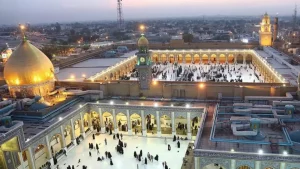History of the Bosnia War [Part 1] – Thirty Years After Srebrenica
By Ibrahim Moiz
15 July 2025
Bism Allah Al-Rahman Al-Rahim
A Terrible Anniversary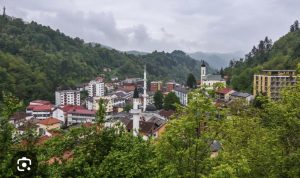
Srebrenica, Bosnia
This month marks thirty years since one of the most vicious massacres of recent history, of eight thousand Muslim men and boys at the eastern Bosnian border town Srebrenica in July 1995. The Srebrenica massacre was simply the most climactic massacre in a genocidal campaign by Serb ethnonationalists, which helped break up the former Yugoslavia in the 1990s a most viciously directed its violence at Bosnia.
Though there has been much coverage of the Bosnian genocide, with Muslims worldwide shaken to solidarity, the war’s general trajectory and the escalation to genocide are little-understood by many foreign Muslims even as their implications continue to reverberate beyond Bosnia.
This first article in our series will examine the background and political-military history of the Bosnian war, before we move on to its dynamics in the context of Muslim solidarity, anti-Muslim propaganda and pseudo-nativism, and international institutional feebleness.
I. Ethnonationalism and Islam in Yugoslavia The Balkan Tinderbox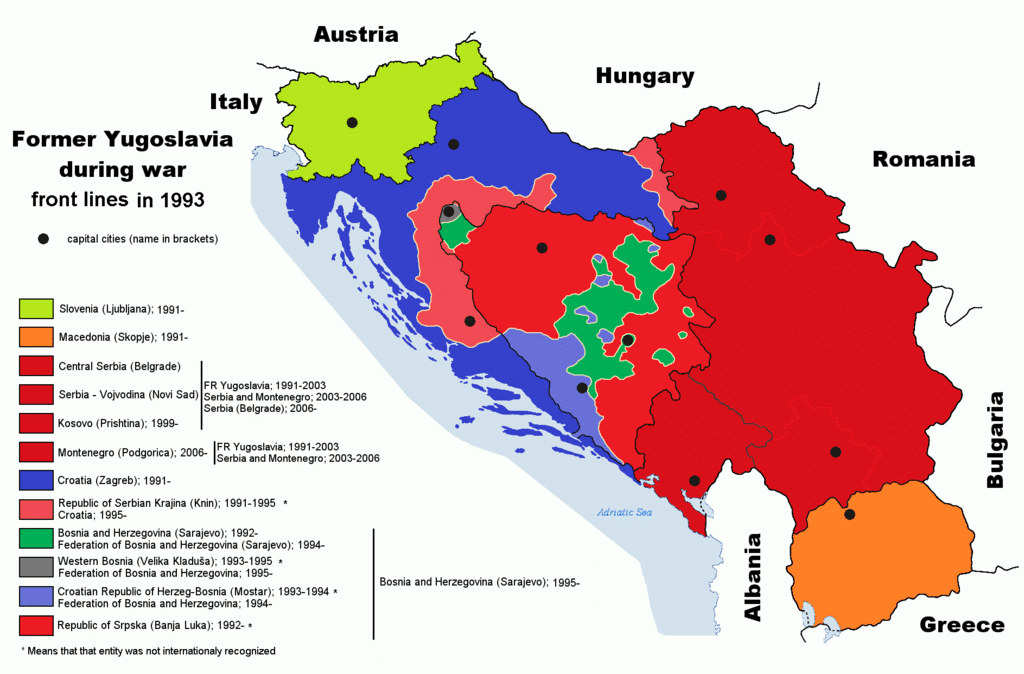
Map of Bosnia and Herzegovina showing major frontlines and regions during the 1992–1995 war (Public domain, U.S. CIA)
Since the nineteenth century, it has been a cliche to call the Balkans a tinderbox of local parochialism and competition by neighbouring powers. An early site of nationalisms, such as Serbian and Albanian, that in turn were exploited by foreign rivals of the Ottoman sultanate or Austro-Hungarian empire, it is often noted that Bosnia’s capital Sarajevo witnessed the assassination, by a Serb ethnonationalist against the Austro-Hungarian heir-apparent, that kicked off the First World War. The region suffered many wars in the first half of the twentieth century, and though under Broz Tito it became a stronghold of the Non-Aligned Movement, his celebrated balancing act between different ethnic groups was improvisational and occasionally repressive, if less than the Soviet Union or neighbouring Albania.
Yugoslavia’s partial federalism, with a certain regional autonomy, contained but institutionalized differences. Both at the capital Belgrade and in the various regions, ruling bodies and state institutions–such as the military, local militia, and security–were balanced among communists of different ethnic groups. Serbs comprised the largest, most far-flung group, and were often suspicious of ethnic Albanians in Kosovo, both because of Kosovo’s importance to Serbia’s identity and because of rivalry with neighbouring Albania.
By the 1980s, with the communist edifice in decline and replaced increasingly by ethnic nationalism, ideologues such as Dobrica Cosic were presenting Serbs as natural but long-aggrieved defenders of the region. Such discourse often entered not only ethnic but also religious bigotry, with the largely Catholic Croats and largely Muslim Albanians and Bosniaks a target. Though partly reactive ethnonationalism also surged among Albanians and Croats, it was Serb ethnonationalists who presented themselves as defenders of Yugoslavia’s unity even as they increasingly engineered state institutions to their exclusive favour.
Slobodan Milosevic And EthnonationalismNobody exploited this ethnonationalism to greater effect than Slobodan Milosevic, boss of the Serbian region, who shot to prominence in the late 1980s in a manner that will be familiar today: turning corruption into an ethnic issue, manufacturing hysteria against minorities, and playacting as a champion of his kin against a supposedly oppressive state apparatus–an apparatus that was, in fact, exceedingly indulgent of and increasingly politicized in his favour.
Rival nationalism was stoked with particular success by Franjo Tudjman, a former general, in Croatia. While the West widely applauded nationalist alternatives to communism in these last days of the Cold War, in fact nationalists in the Balkans were largely former communist apparatchiks, most of whom came to lead their region in Yugoslavia.
Alija Izetbegovic And Fikret Abdic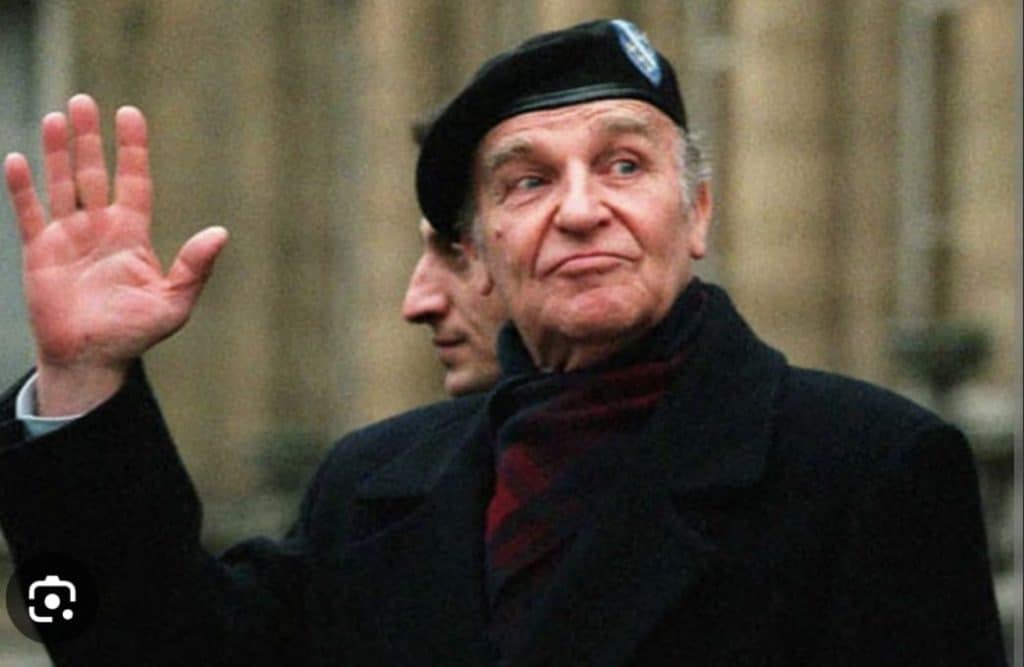
Alija Izetbegović, Bosniak leader and first President of independent Bosnia and Herzegovina
A major exception was the Bosniak (Bosnian Muslim) ideologist Alija Izetbegovic, the only regional leader from outside the Yugoslavia elite; he had been put on a show trial in 1983 for a supposed plan to create an Islamic state. In fact he had simply written on basic Islamic political principles, none of which entailed forcing the religion; he saw moral persuasion as the best route to Islamic revivalism, religious and cultural rather than politics as ideal for Islamic revivalism in a largely secularized society. Though critics suspicious of “Islamic fundamentalism” would labor to equivocate him with nationalists because of his Islamic convictions, those same convictions abhorred nationalism and he aimed to preserve, not force, Islam–a far cry from the clumsy, exclusivist amalgamations of Serbian nationalism with Eastern Orthodoxy or Croatian nationalism with the Catholic faith by recently transformed former establishmentarians such as Slobodan Milosevic and Tudjman.
A very different, but initially popular, type of Bosniak leader was Fikret Abdic, a tycoon whose northwest Bihac region had a rare amount of inter-ethnic harmony that ensured his popularity even after he was embroiled in a corruption scandal. He actually secured more votes than Izetbegovic in the 1990 regional election, and was made a member of a coalition Bosnian council.
II. The Breakup of Yugoslavia Summer 1991Albania, whose communist regime succumbed to protests, was a warning sign, especially because Kosovar Albanians led by Ibrahim Rugova fled there to found an exile opposition. It was clear that Yugoslavia would either reform, rupture, or both: Croatia, led by Tudjman, and Slovenia favoured rupture; both Bosnia, where Izetbegovic had recently come to power, and Serbia ironically opposed secession, for opposite reasons: Izetbegovic favoured a federalist Yugoslavia with reforms, especially since ethnic secession would hit Bosnia hardest; Milosevic marketed himself as the champion of Yugoslav unity, portraying any reform as treasonous; by the year’s end a series of palace intrigues had collapsed the government and put him in charge of not only Serbia but the collapsing Yugoslavia state.
The fact that a reunified Germany, in particular, was encouraging Slovenia and Croatia to declare independence also rallied Yugoslav state institutions like the army behind Milosevic, who portrayed Serbs as the guardians of the state. In summer 1991 both Slovenia and Croatia broke away; Slovenia had very few Serbs, so after a brief military campaign it was let go. Essentially this led to a precedent where a Yugoslavia-versus-separatists stance was replaced with an ethnic war.
Serb-Croat War
Typical communist-era architecture in Belgrade, the former capital of Yugoslavia.
Croatia was a different matter, its sizable Serb periphery led by Milan Babic calling to join Serbia. This would only be connected via Bosnia, whose most influential Serb ethnonationalist – Radovan Karadzic – assumed a similar posture. A vicious war soon broke out between Serbs, joined by the Yugoslavia army, and Croats on Bosnia’s border.
Croat-Serb polarization affected both Belgrade–where a bloodless coup replaced the Croat figurehead ruler of Yugoslavia, Stjepan Mesic, with the Serb Milosevic–and Bosnia, where rival ethnic enclaves were set up, Mate Boban leading a Croat enclave that favoured Croatia and Karadzic taking the opposite stand.
Institutions, including Izetbegovic’s ruling council in Sarajevo had been carefully split between Bosnia’s Bosniaks, Croats, and Serbs: Bosniak security chief Alija Delimustafic and Serb militia commander Dragan Vukosavljevic backed Belgrade against Croatia. The Yugoslav army’s commanders from the war against Croatia–notably Milutin Kukanjac and Ratko Mladic–also armed Serb militias, setting up Karadzic’s headquarters in the mountains outside Sarajevo, and the war occasionally spilled over against Croat villages in Bosnia. Izetbegovic did form a militia, led by Sefer Halilovic, that was loosely linked to his Akcije party, but its role was strictly defensive.
Croatian IndependenceBy 1992 Tudjman had won recognition of Croatian independence, effectively confirming Yugoslavia’s death. In spring 1992 a referendum secured Bosnia’s independence and left Milosevic in charge of the rest, now called Serbia. Croatia was strongly supported by the West, Serbia by Russia; Bosnia had neither.
The United Nations had rushed a force of peacekeepers to the scene, but its Canadian commander Lewis Mackenzie remained openly hostile to Bosnia. The United Nations then reached a typically untimely bandaid solution in the form of an arms embargo: this came after Serbia had already armed Karadzic’s militants to the teeth and retained a major army force led by Kukanjac in the country. It left Bosnia, easily the weakest of the newly independent states, with very little defense.
III. Encirclement and Attack Spring 1992: Serbs Converge on Bosnia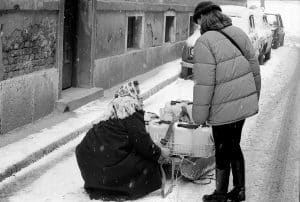
Sarajevo residents fetching water under sniper fire, winter 1992–1993. (Photo: Christian Maréchal)
In spring 1992 not only Serb ethnonationalists but the Serbian army converged on Bosnia. There were three major prongs: in the centre, Kukanjac and Karadzic laid siege to Sarajevo; in the west, Mladic thundered south from the Croatian battlefield through the Kupres and Neretva river valleys; and in the east, Dragoljub Ojdanic crossed the eastern border and swept south through Zvornik, hoping to cross southern Bosnia and meet up with Mladic in the southwest. Only in isolated cases–Zepa, where Avdo Palic ambushed the Serbian army, and Gorazde and Srebrenica, where Zaim Imamovic and Naser Oric held out under siege for three years–were they interrupted.
Ethnic Cleansing and Atrocity CampaignsThe Serbian army employed Serb ethnonationalists from throughout the old Yugoslavia, such as Arkan Raznjatovic, Mirko Jovic, and Vojeslav Seselj: they openly spoke of Islam as an alien and inferior presence, often describing Bosniaks as alien Turks, and armed to the teeth they regularly rounded up non-Serbs, Bosniak and Croat, and massacred them. For Serb ethnonationalists massacres were intended to eliminate or at least expel non-Serb populaces in order to claim their land as part of the Serb homeland; rape was a frequent phenomenon intended to break the spirit of their victims’ communities.
Political Defections and Siege Dynamics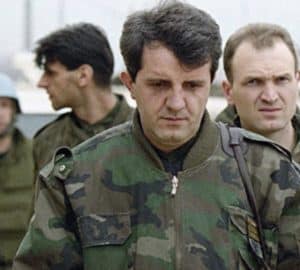
Sefer Halilović, Bosnian army commander
Any illusions the Bosnian government maintained of keeping the peace soon evaporated. The Serb members of the Bosnian government, academics Nikola Koljevic and Biljana Plavsic defected to join Karadzic, as would their replacement Nenad Kecmanovic, and constable Vukosavljevic led a slew of similar defections by Serb officers. While Izetbegovic negotiated abroad, two Bosniak government leaders–his tycoon rival Abdic, also on the ruling council, and interior minister Delimustafic–also attempted a coup on the same day that the Serbian besiegers launched a major attack; Izetbegovic, rushing back from Lisbon, was captured at the airport by Serbian soldiers.
Fortunately for Sarajevo, Izetbegovic’s deputy Ejup Ganic as well as military commanders Hasan Efendic and Halilovic kept their wits about and captured Serbian army commander Kukanjac. He was only released in exchange for Izetbegovic, but Halilovic promptly captured him again. The aggressive Halilovic, now Bosnian army commander, was at the centre of considerable misgivings between the Bosnian leaders. Particularly controversial, though certainly necessary at the time, was his reliance on Sarajevo’s unsavoury mobsters to help man the front until the army built up; not till late summer 1992 was an army corps, led by Mustafa Hajrullahovic, ready.
IV. A Common Enemy: Bosnia against the Ethnonationalists Bosniak–Croat Military Cooperation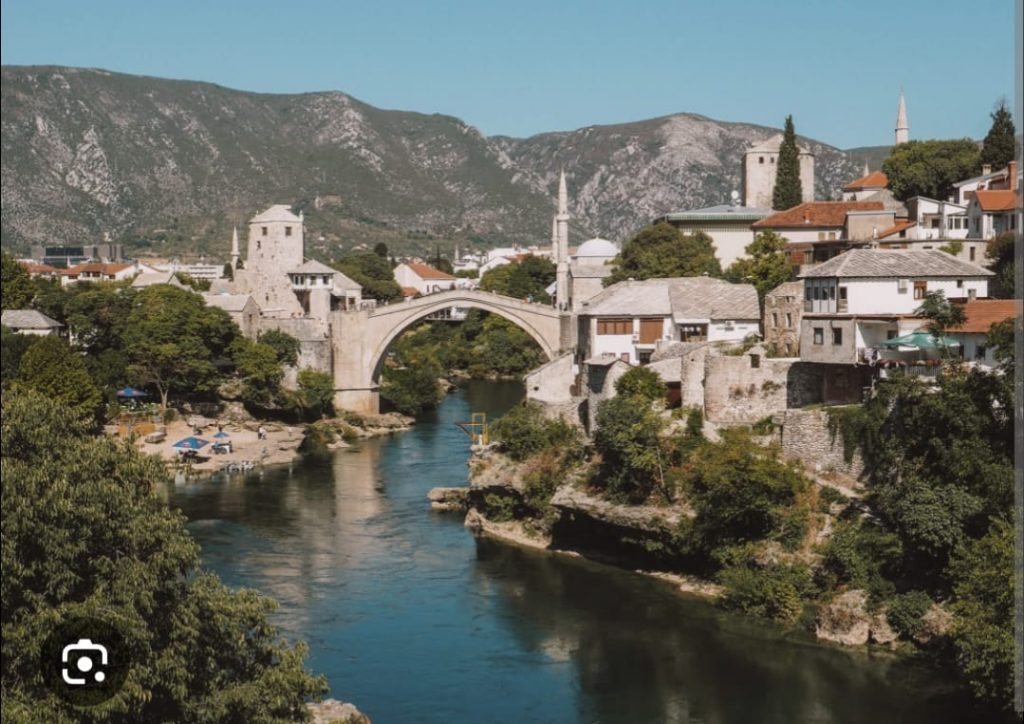
Mostar in Southwest Bosnia, a major battleground during the war.
Caught unawares and unready by the Serbian offensive, Bosnia had relied heavily on the more experienced Croat militia against their common Serbian rival. Croat nationalism had a more mixed view of Muslims at this stage than did Serb nationalism; indeed the Croatian army included a large number of Albanians from Kosovo. Within Bosnia, the Bosniak mayors of the cosmopolitan towns Tuzla and Mostar, respectively Selim Beslagic and Ismet Hadziosmanic, cooperated closely with Croat commanders Zeljko Knez and the Muslim Jasmin Jaganac. Another friendly Croat commander, Blaz Kraljevic, had helped take Trebinje from the Serb forces, and soon Izetbegovic and Tudjman were aiming to formalize their cooperation.
Boban–Karadzic Conspiracy and BetrayalYet behind the scenes the respective Croat and Serb ethnonationalist leaders, Boban and Karadzic, decided that it was best to split Bosnia, whose defence was easily the weakest and whose Muslim population both despised, between them: an early hint of this conspiracy came with the murder of Kraljevic, and it exploded to the fore in autumn 1992. The plotters’ takeover of Bosanski Brod hamstrung the government’s attempt to retake Zvornik from Serb militants. In an ironic twist, the government’s commander here, Knez, was an ethnic Croat, while the Bosanski garrison was led by Armin Pohara, a Bosniak actor with links to different sides of the conflict who appears to have been confused by circumstances beyond his control.
Escalation to the Bosniak–Croat WarSuch local nuances did not prevent the Croat ethnonationalists from plundering or expelling Muslims from other towns they captured, including Jajce, Prozor, and Travnik. While Croat militants were never as uniform in hostility to Muslims as Serb militants, by 1993 a general war between Bosniaks and Croats was underway; Croats who cooperated with Muslims were increasingly sidelined.
In spring 1993 Boban’s deputy Dario Kordic and Tihomir Blaskovic, particularly brutal commanders, blazed through the Lasva valley, massacring and expelling Muslims; having jointly fought the Serb rebels at Mostar, Croat commanders Slobodan Praljak and Milivoj Petkovic turned on their Muslim counterparts Arif Pasalic and Sulejman Budakovic.
Despite talks between Boban and Alija Izetbegovic, Blaskovic rejected any reconciliation and even replaced the tolerant Croat commandant in Fojnica, Stjepan Tuke, with a vicious lieutenant Ivica Rajic, who advanced to Vares and massacred Muslims.
Not till summer 1993 did Bosniaks respond with anything like the same ruthlessness. A Bosnian attack led by Enver Hadzihasanovic captured Fojnica and Bugojno, and in contrast to previous or future practice expelled the towns’ Croats. This was quickly seized upon by foreign outlets as proof that the Bosniaks were “no angels”–as if that was a prerequisite to avoid genocide. The fact was that even at their worst Bosniak soldiers did not resort to ethnic cleansing, systemic massacres, or cultural destruction: there was no equivalence with Croat or Serb ethnonationalist atrocities.
V. International Institutions: Hurting not Helping The Vance–Owen Peace PlanEthnonationalism was further incentivized by a gormless international response: in early 1993 United Nations envoy Cyrus Vance, whose earlier mediations in the Balkans had hardly been helpful, joined with United Nations envoy David Owen to argue for the splinter of Bosnia into ethnic cantonments. Portrayed as statesmanlike nuance, this in effect only encouraged Serb and Croat ethnonationalists to carve up Bosnia between them.
UN Peacekeeper FailuresSuch pompously harmful edicts underscored a general tendency in international institutions like the United Nations: recognizing the Western support for Croatia and the weakness of Bosnia, they opted for the laziest and easiest presumption that Bosnia should be sacrificed for the “greater good” rather than moralize Serbia. Like his Canadian predecessor Mackenzie, United Nations commander Philippe Morillon of France inclined toward Serbian commander Mladic, whose swaggering confidence endeared him to fellow officers.
Western Prejudice and Muslim SolidarityWhile Western states had been glad to advocate for Croatia against Serbia, they were quite willing to sacrifice Bosnia and dress this up as a necessary sop to Russia: at the highest levels France and, with only slightly less distasteful enthusiasm, Britain evinced their distaste for a Muslim state in Europe.
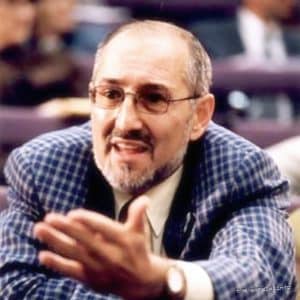
Hasan Cengić, Bosnian Finance Minister (1992–1995), known as the “Flying Imam” for his diplomatic fundraising flights.
Washington was not as prejudiced against Bosnia, but inclined to side foremost with Croatia and definitely suspicious of Sarajevo’s links to Muslims abroad in an age where “Islamic fundamentalism” was beginning to emerge as a post-Cold War enemy of choice. Croatian leader Tudjman, so recently hobnobbing with Izetbegovic, now expounded on the “alien” nature of Muslims in Europe, echoing Serb propaganda. In a region torn apart by ethnonationalism, the one government that transcended it, Sarajevo, was portrayed as a wildcard for its Islamic links, epitomized in the energetic activity of finance minister Hasan Cengic, whose frequent trips for support earned him the nickname “flying imam”.
Such links were of course a natural response to Bosnia’s plight, and a number of state and private Muslim actors did chip in. From pro-American regimes Saudi Arabia’s future king Salman bin Abdul-Aziz and Kuwait’s emir Jabir bin Ahmed sent support. Hussein Abdel-Razek from Egypt, Fazlur-Rahman from Bangladesh, and Qasim Qureshi from Pakistan led United Nations units and tried to bypass institutional apathy. But U.S. policymakers fretted over support from Sudan’s Hassanayn, Iran’s Akbar Torkān, and Pakistan’s spymaster Javed Nasir—whom Washington forced out as “fundamentalist.”
Propaganda, Media Bias, and High-Profile AbductionsNon-state actors were viewed with even more suspicion: these included civilian aid administrators, such as Muhammad Sharhan of Kuwait; a Hadrami Islamist called Mahmoud Bahaziq, often called “Abu Abdul-Aziz Barbaros” in disproportionate media focus; and foreign volunteer battalions led by the North Africans Doctor Abul-Harith and Jamal Abul-Maali, the Arabian Muhammad Habshi (Abul-Zubair), and even Ali Fayad, who led a unit from the Lebanese Hezbollah.
The Bosnians’ enemies latched onto this solidarity as proof of a villainous Muslim plot to infiltrate Europe; several Israeli propagandists, such as Yossef Bodansky, seconded themselves to Serbia to lobby against Bosnia as part of general Israeli support for Serbia. In fact, despite such innuendo, Muslim volunteers were guilty of little more than a culture shock; late in the war Abul-Maali would execute fifty captured Serb fighters, but this paled compared to the systemic and repeated crimes against civilians by Bosnia’s enemies.
Nonetheless, institutional biases toward Muslims, not only foreigners, often prevailed: this was epitomized by the coverage of Srebrenica’s tough sheriff Naser Oric. In early 1993 he led a breakout and raided Serb villages in order to feed the starving town; Serb nationalists immediately portrayed this as an assault on Serbs and an unimaginable war crime, an angle that was widely spread abroad.
Foreign coverage preferred United Nations commander Morillon, who–mobbed by desperate Srebrenica families as he visited the besieged enclave–solemnly promised never to abandon them. Despite a glowing foreign reception for this theatre, Morillon would manifestly fail to keep his promise and would in fact go on to obfuscate in Serbia’s favour. Perhaps nothing epitomized international failure as obviously as the abduction of Bosnian vice-prime minister Hakija Turajlic by Serb separatists in Sarajevo; seized under the noses of indifferent United Nations “peacekeepers”, he was quickly murdered in an indictment of international institutions.
VI. American Mediation and its Limits Reorganizing Sarajevo’s Defense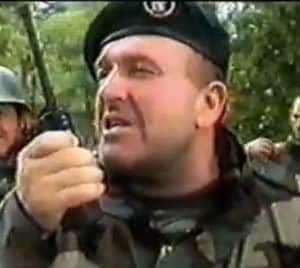
General Atif Dudaković, Commander of the 5th Corps, Army of the Republic of Bosnia and Herzegovina
In summer 1993 Sarajevo’s defense was overhauled: the irascible Halilovic, whose uncompromising opposition to Croat militants and support for the Sarajevo cartels had earned him a black mark, was unceremoniously sacked in favour of a more discreet Rasim Delic.
Halilovic’s rivals Fikret Muslimovic and Enver Mujezinov cracked down on the mobsters–one of whom, Caco Topalovic, was killed: instead of such unsavoury militias, the army took a more organized approach in the city’s defence.
New Corps Commanders in the Field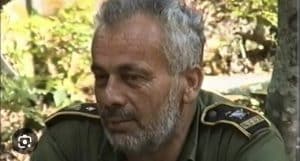
Mehmed Alagić, Bosnian Army Corps Commander at Travnik.
Similarly the Akcije government began to establish control, both emphasizing the Islamic nature of their struggle and trying to restore confidence abroad. In the field they promoted commanders who were not only experienced but also reliable: for example, Tuzla’s new corps commander Sead Delic was more reliable than his wilful predecessors Knez and Hazim Sadic.
Salko Gusic was sent to shore up the sensitive Konjic front; Vahid Karavelic at Sarajevo, Mehmed Alagic at Travnik, Sakib Mahmuljin at Zenica, and Atif Dudakovic at Bihac were experienced and loyal to the regime.
The 1994 Washington AccordExternally, American commitment to Croatia had precluded support to Bosnia, but their priority had been Serbia and now they sought to end the 1993 Bosniak-Croat war. One promising sign was the replacement of the Croat separatist Mate Boban with Kresimir Zubak, who negotiated under the auspices of American leader Bill Clinton with Bosnian prime minister Haris Silajdzic. This culminated in the spring 1994 Washington Accord, joined by Izetbegovic and Tudjman, that effectively ended the 1993 Bosniak-Croat war and redirected them against Serbia.
The coalition kicked off when Croat forces helped Alagic and Kadir Jusic break the Serb siege of Maglaj. Another siege, led by Serb commander Dragisa Masal against Gorazde commander Zaim Imamovic, was only narrowly averted when United Nations commander Michael Rose unprecedentedly launched airstrikes — Masal and his boss Ratko Mladic vented their spleen at this narrow loss by, respectively, massacring Muslims and seizing United Nations soldiers. The Serb commander at Ozren, Novak Djucic, had more success in repulsing a three-pronged assault led by Sadic, Jusic, and Refik Lendo.
Fikret Abdić’s Mutiny and the Bihać SiegeA Bosnian-Croatian detente also complicated life for Fikret Abdic; having failed to oust Izetbegovic in 1992, this tycoon had in autumn 1993 conspired with Boban to turn over Bihac, on the Croatia-Bosnia border. Abdic had wealth and influence in this region, so when he incited a mutiny against Bosnian commander Ramiz Drekovic it had put the Bosnian regime at a quandary. He enjoyed portraying the Akcije regime as fanatics and won the trust of such credulous diplomats as Owen by confirming their prejudices.
But with Boban and Croatian protection gone, Abdic’s prospects looked uncertain. He thus jumped at an opportunity when Bosnian soldiers offered another mutiny, and quickly ordered his supporters to join them. To their horror, they walked into a trap laid by the formidable new commander Atif Dudakovic, who quickly apprehended them and marched on Abdic’s stronghold Velika Kladusa. Mladic responded with a two-pronged assault, but it backfired and the Serbian commander only narrowly evaded capture. Abdic now allied himself in open with Serbia; two Serb separatist corps, led by Momir Talic and Radivoje Tomanovic, pushed Dudakovic back to Bihac and put him under siege.
VII. An Enabled Massacre Shift in UN/US PrioritiesThe undisguised motivation of the American and United Nations intervention in 1994 had been to pressure Serbia, rather than help Bosnia per se; indeed their commander Rose, who had helped save Gorazde only months earlier, balked when the Bosnian army tried to break the siege of Sarajevo. Independent Bosnian action was anathema, and when the Bosnian army tried to recover strategic heights in spring 1995 the United Nations turned firmly against them.
Failed Bosnian Summer Offensive and the Fall of Srebrenica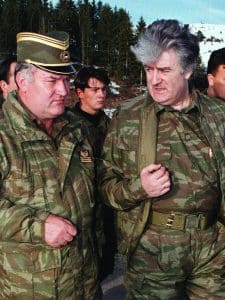
Radovan Karadzic and Ratko Mladic, masterminds of Bosnian genocide.
In turn, the Bosnian army made a major, and rash, attempt to break the Sarajevo siege in summer 1995, when Sead sent forces from Tuzla to help Karavelic’s offensive. Not only was this repulsed with heavy casualties, but it left eastern Bosnia dangerously undermanned.
Ratko Mladic seized advantage of this, and concentrated his far larger army on the long-besieged Srebrenica enclave. Its dashing commander Naser Oric, widely vilified abroad, had recently been recalled to Sarajevo; instead a small garrison was left under the command of the ailing Ramiz Becirovic. Two years earlier the United Nations had pledged to help Srebrenica, but their only unit, a Dutch force led by Thom Karremans, put up no resistance; instead Mladic, who always disguised his brutality toward civilians with roguish humour toward foreign soldiers, regaled him with alcohol.
With relish, Mladic flaunted his power over the captured Bosniaks, and had as many as eight thousand butchered in cold blood, many lured to the slaughterhouse by their coerced families. Bosnia had seen many massacres over the past few years, the vast majority at the hands of Serb ethnonationalists, but this marked the crescendo of a full decade of hate-mongering, ethnic supremacism, and ultimately genocide under the banner of Serb ethnonationalism.
VIII. Blitz and Betrayal The Split Accord and Joint Counter-Offensive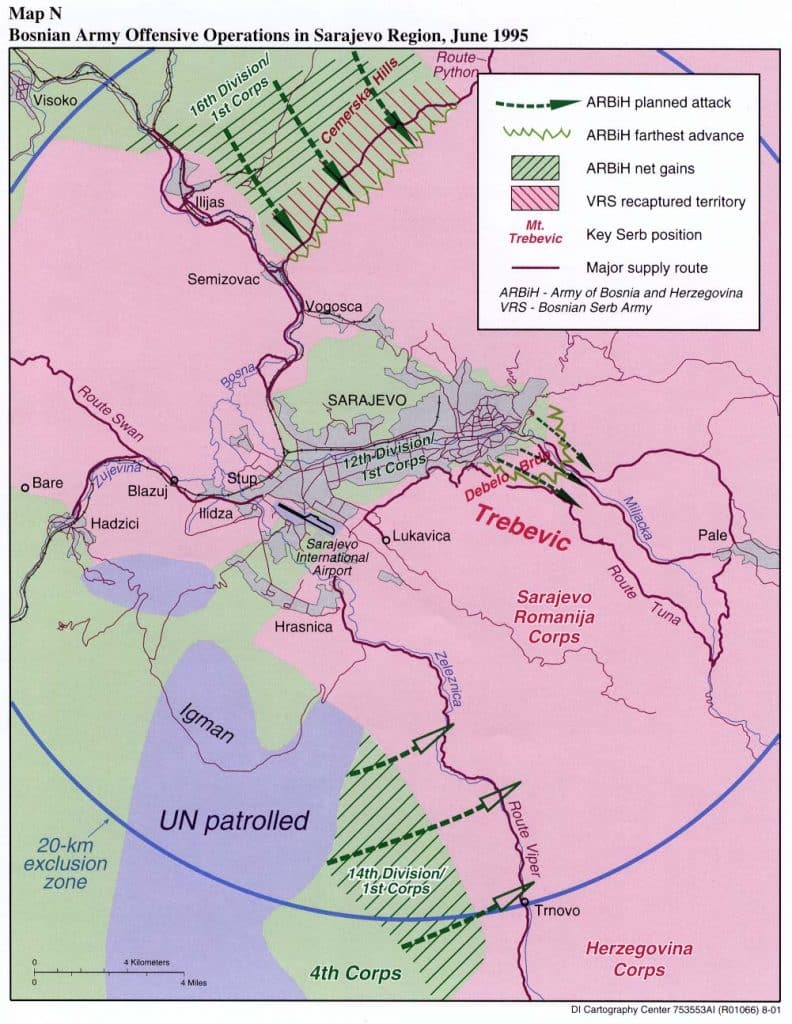
Military action surrounding Sarajevo, Bosnia in June 1995
The only way forward from such unrepentant genocidal brutality is down, and so it happened. Serbia overreached by assigning its army in the west, led by Mile Mrksic, to finish off the campaign in western Bosnia opposite the Croatian army. To mend any remaining splits, the Bosnian and Croatian leaders signed the Split Accord–so named for the Croatian corps’ headquarters on the western coast–and, assisted by Dudakovic’s Bihac corps, blitzed the Serbian army and its vassals in Bosnia and Croatia– Karadzic, Milan Martic, and Bosniak quisling Abdic.
Recapture of Bosnian TerritoriesIn autumn 1995 Croatian corps commander Ante Gotovina joined his Bosnian counterparts Dudakovic, Alagic, Mahmuljin, and even the foreign Muslims led by Abul-Maali in recapturing Bosnian towns such as Jajce, Petrovic, Donji Vakuf, and Vozuca; Zaim Imamovic, who had braved years under siege in Gorazde, was martyred on the campaign’s last day. Among the Serb opposition they routed was the infamous Arkan Raznjatovic, recently dispatched by Milosevic from Serbia in a vain attempt to reconcile the squabbling Mladic and Karadzic.
The Dayton AccordYet this avalanche of good news screeched to a halt when the United States, under bullish mediator Richard Holbrooke, called a ceasefire and hammered out the most flawed of compromises in the Dayton Accord. Not dissimilar to the 1993 proposals of Owen and Vance, it created an ethnic enclave for Serbs in Bosnia, essentially rewarding Karadzic’s three years of ethnic cleansing and ensuring an island of Serb ethnonationalism remained in Bosnia. It also slapped a foreign commission for Bosnia, led first by former Swedish prime minister Carl Bildt, that would act as a sort of viceroy; the Americans, naturally, would enjoy a veto on great matters.
Izetbegovic’s Reluctance and Silajdzic’s BreakThe Accord should put paid to any delusions that the United States had entered Bosnia as a friend to its people, and at first Izetbegovic was too appalled to sign. But he lacked the cards to do anything about it–he could just about face off Serbia, but a United States at the peak of its power, backed by Europe, including the important Croatia, was beyond his capability after three years of horrendous war. The Akcije regime was exhausted and struggling; in summer 1995, prime minister Silajdzic had broken away.
Assassinations and DisappearancesAlready as Commissioner Bildt arrived to take up his seat, signs of the more sinister side of American power had appeared; several Arab officers, including Abul-Maali, were murdered. The first known case of disappearance had also occurred, when an Egyptian ideologue called Talaat Qassemi, who had some informal links with some Arab fighters, was abducted in Croatia.
Growing Suspicion of Muslim VolunteersThe United States might not have been as unhelpful as several European states, but though it was less indiscriminate its mounting antipathy to “Islamic fundamentalism” was a rare point of agreement with Milosevic. Though Izetbegovic would do his best to shield them, foreign Muslim volunteers would come under an increasing American and European cloud over the years.
Milosevic’s Kosovo Pivot and a Forgotten LessonAs for Milosevic, the results of the Dayton Accord were satisfactory enough for him that he turned on his original target of choice, the (similarly largely Muslim) Albanians of Kosovo. It was here that he would overstep, giving Washington a pretext to finish him. But it was a shame that it took thousands of Bosnian lives to hammer home the lesson that bigotry, ethnic cleansing, and genocide should not be rewarded. Unfortunately, the lesson is once more forgotten today.
Check back for part 2: Continued relevance of the Bosnia war in today’s climate of hate.
Related Posts:Oped: The Treachery Of Spreading Bosnia Genocide Denial In The Muslim Community
The post History of the Bosnia War [Part 1] – Thirty Years After Srebrenica appeared first on MuslimMatters.org.

 Diane Abbott, 2010
Diane Abbott, 2010 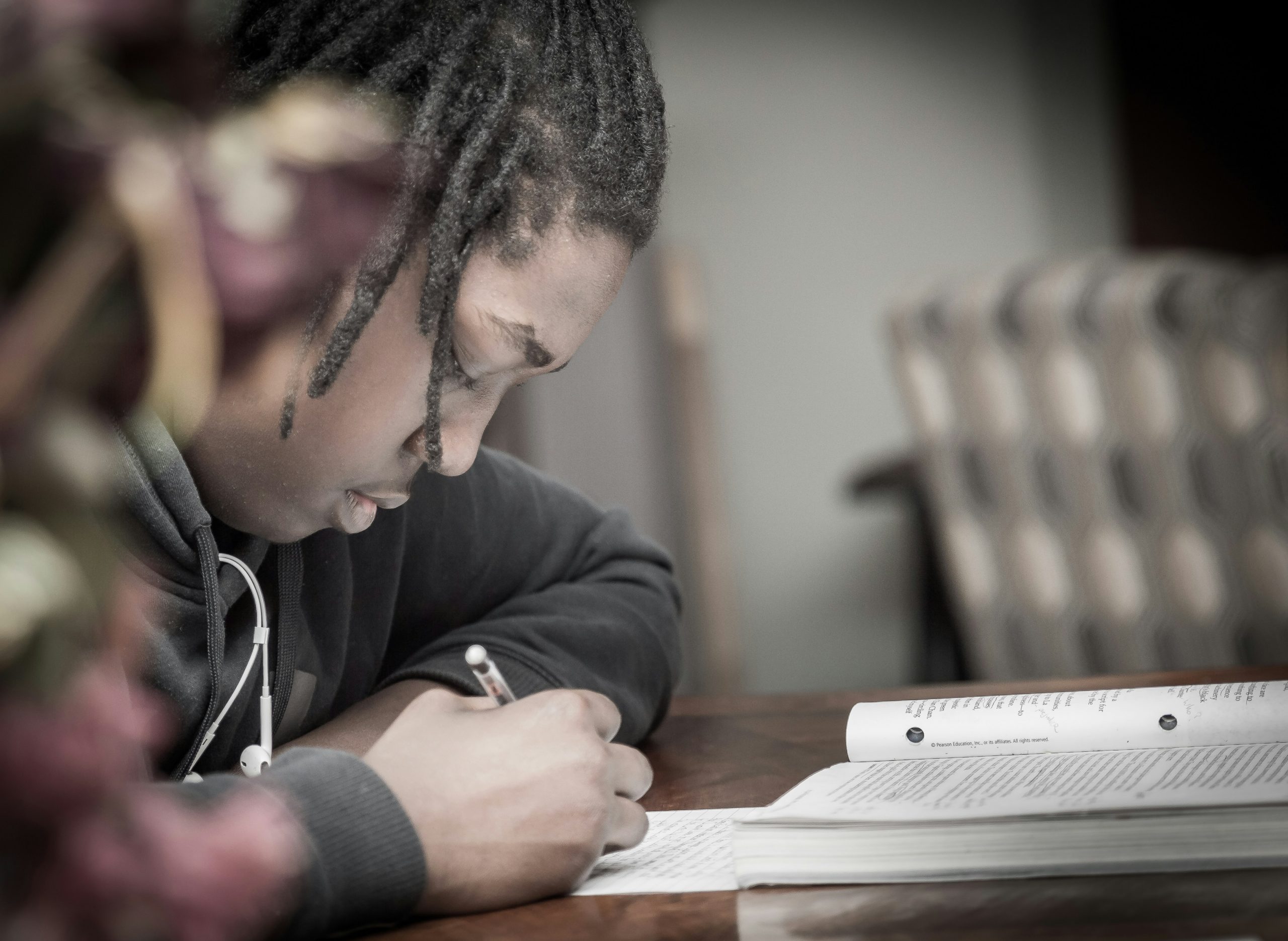
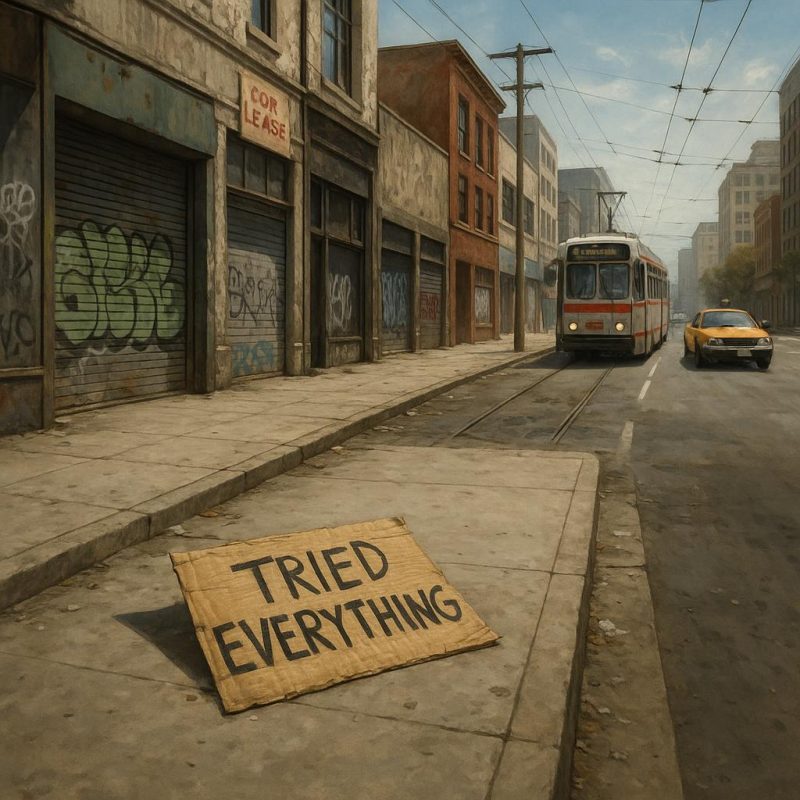
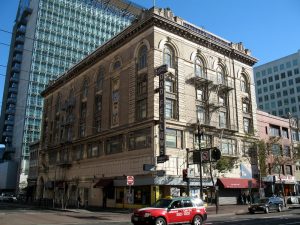
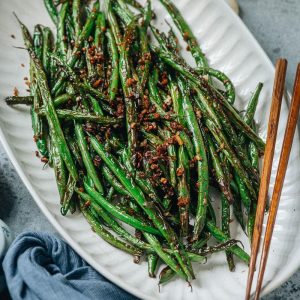
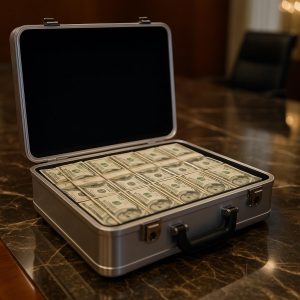

 Mercy and Power: the deliverance of Prophet Musa
Mercy and Power: the deliverance of Prophet Musa  and his followers from Pharaoh, and the safe landing of Prophet Nuh’s
and his followers from Pharaoh, and the safe landing of Prophet Nuh’s  , who was martyred in Karbala while standing for justice and truth. These narratives are not mere historical occurrences, but are intricately woven with profound lessons that resonate with Muslims today.
, who was martyred in Karbala while standing for justice and truth. These narratives are not mere historical occurrences, but are intricately woven with profound lessons that resonate with Muslims today.

